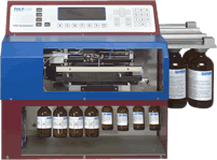
Minimal space requirement
The compact design
41 x 43 x 40 cm
(LxDxH)
means that a small area only
is required.
•20 % higher flow-rate
•modified drive system for
high flow-rate
• 8 Amidite positions
•3 additional inlets for
reagents
Suitable for creating RNA, LNA
and premixed Wobbles
(www.safcproligo.com)
Upon customer’s request housings
can be printed with individual designs.
>more
|
| The advantages of the PolyGen Synthesizer: |
|
|
 |
Minimal reagent
consumption
- Extremely economical in reagent consumption due
to the patented
Slider Block of low dead volume (ca. 3 µl).
In the fast program:
only 0.6 ml total solvent consumption per coupling
In the high-quality program:
only 1.1 ml total solvent consumption per coupling
- Measurement of reagent addition is by integrated
metering pump
- Variable flow rates and times in each individual
program step
|
 |
No expensive pre-packed columns
necessary
- Costly consumables such as pre-packed columns
become unnecessary
as the reaction vessels are integrated in the Slider Block system
- The CPG materials are directly fed into the column
slider.
|
 |
Wide synthesis range
- From 10 nmole - 1 µmole per column.
- From 1 µmole - 5 µmole with separate Slider
|
 |
Short synthesis
times
- 12 couplings in 6 minutes - 12 oligo-syntheses
in one run
(12-Column DNA Synthesizer).
- 20-unit Poly-T in 1h 45 min using the fast program
and up to 2 h 55 min
using the high-quality program.
|
 |
High degree
of user-friendliness and ease of maintenance
- No valve replacement required.
- Maintenance-free due to patented Slider Block
system.
- Service and maintenance contracts unnecessary.
|
 |
Direct
data transfer from PC
- The 12-Column DNA Synthesizer can be operated
as a stand-alone
instrument or with various software suites via
PC.
- Thus the direct transfer of sequences from your database into
the synthesizer is possible.
|
 |
Flexible,
user-oriented software
|
 |
DMT system for reliable
process monitoring
- Each individual column can be monitored by DMT;
the entire synthesis process is thus constantly under review.
If the minimum required absorption is not achieved, a warning
signal is given; alternatively,
the process can be stopped.
|
| |

